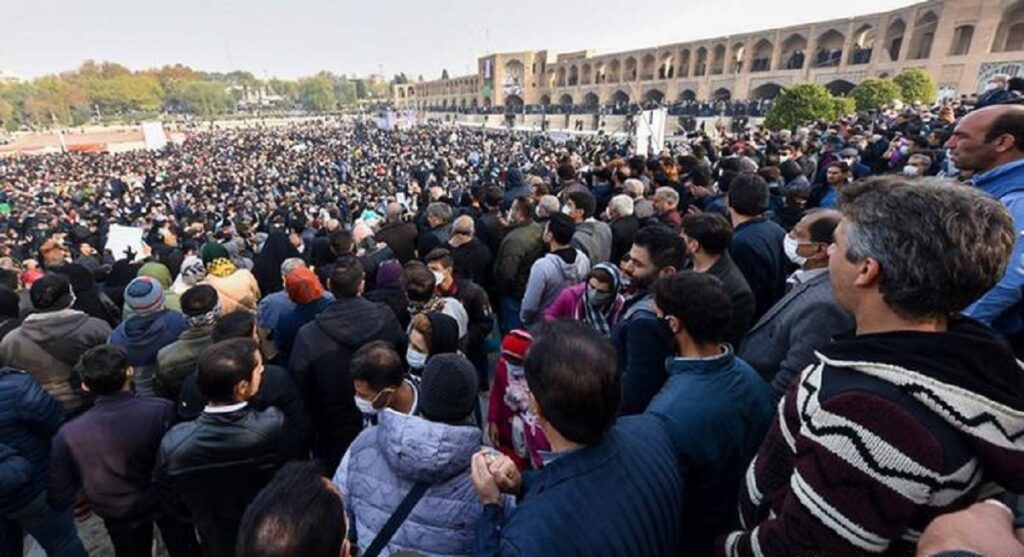Farmers in Isfahan, central Iran, have been suffering from water shortages for years and their calls on authorities for help have fallen on deaf ears. Protests by groups of farmers have been ongoing but it has escalated in recent months reaching a climax in November when hundreds of farmers started a sit-in on the dried basin of Zayandeh-Rud river, which historically served as farmers’ lifeline. Their move rapidly gained public support and they were joined by thousands of locals.
Their protests turned political following repressive measures by security forces and people started chanting slogans against the regime.
Isfahan’s water shortage is part of a severe water crisis across Iran. This has impacted the lives of thousands of Iranians and threatens the existence of the historic city of Isfahan.
Iran, with an approximately 85 million population, some 28 million people live in severely water-stressed areas, mostly in the central and southern regions of the country.
As Iran has a predominantly arid and semiarid climate, water has always been a top priority for its people, who have a long tradition of sustainable water management.
Like other dramatic socio-economic changes in the 20th century, however, the waterscape of Iran has also been altered. Large-scale dams have been erected, rivers diverted, traditional water sharing rules abolished, wetlands dried up, and precipitation patterns changed while water demand and withdrawals have increased unsubstantially.
The major cause has been unprecedented population growth leading to the expansion of cities, increased water-hungry industries, which shouldn’t be established at those locations in the first place, the devastation of simple rural lifestyles, and disruption of traditional water management systems that had been in place for centuries.
Thus, water scarcity is hitting all segments of society, from urban households to rural farming communities.
Iranian politicians have consistently blamed climate change, droughts, and lack of precipitations for the current water shortages. In contrast, devastating floods of recent years have caused many losses of lives and economic damages. Even though this is a serious problem, a 2021 study in Nature journal categorically stated that most of Iran’s groundwater depletion is “anthropogenic.” It means that it is caused or exacerbated by human activity.
However, one must know that all such environmental crises are government-made crises, which even Iranian experts are admitting total contribution of the government in creating such crises as deforestation, overgrazing of rangelands, sinkholes, land subsidence, the plundering of water resources, and increased desertification Iran’s “Water Mafia,” which protesting farmers rightfully are calling for its abolishment. However, none are coming close to identifying this “Water Mafia.”
Since 1979 Iran’s authorities have cleverly managed the country’s wealth, natural resources, and water resources in the name of the “deprived” but for the benefits of immensely “rich” religious foundations under the Supreme Leader’s supervision, Revolutionary Guards (IRGC), elite clerics, and their affiliates.
Iran’s aquifers have been depleted due to massive over-extraction of underground water resources as the number of deep wells has increased since Iran’s revolution in 1979.
Over the past decades, some of the aquifer levels have dropped by 100 centimeters. In addition, digging illegal wells and improper irrigation methods are the other main causes of groundwater extraction-induced subsidence. Out of 50,000 wells pumping underground water resources around the capital, 30,000 are illegal. Out of 609 plains in Iran, more than 300 are vastly sinking and forbidden to enter.
The IRGC affiliated companies are building dams, regardless of their usefulness for the nation, without any environmental considerations, and farming of water-intensive crops, which are again under the control of affluent IRGC members, elite Clerics, or foundations under the supervision of Iran’s Supreme Leader.
“In Isfahan province, about 300 million cubic meters of water is used for industrial purposes. According to development plans, it is predicted that this figure will reach 500 million cubic meters per year in the next ten years,” wrote the state-run Hamdeli newspaper on November 22.
Among them is Foolad Mobarakeh Steel Industry Group. This huge steel conglomerate belongs to the (IRGC).
“The Basij and the IRGC will support Mobarakeh Steel Group and other industries in the country with all their might,” said Ali Hossein Raiatifard, head of the Workers’ and Factories’ Branch of the Basij Organization, according to the state-run Jahan-e Sanat daily.
“The livelihood of about 300,000 Isfahani farmers is tied to the Zayandeh Rud river. Its dryness has created problems such as land subsidence as well as climate and environmental challenges for the people of Isfahan,” Jahan-e Sanat daily wrote on November 20.
According to some experts, land subsidence in Isfahan is so severe that the city will not be habitable in the next ten years if no immediate and effective solution is devised.
The Iranian government’s mismanagement of water has put the country on the verge of a nationwide water crisis. The Iranian clerics are unwilling to revert their actions as they need revenue to continue their malign activities. Thus, like any other nation under a totalitarian regime, people should pay the price of the authorities’ actions.

